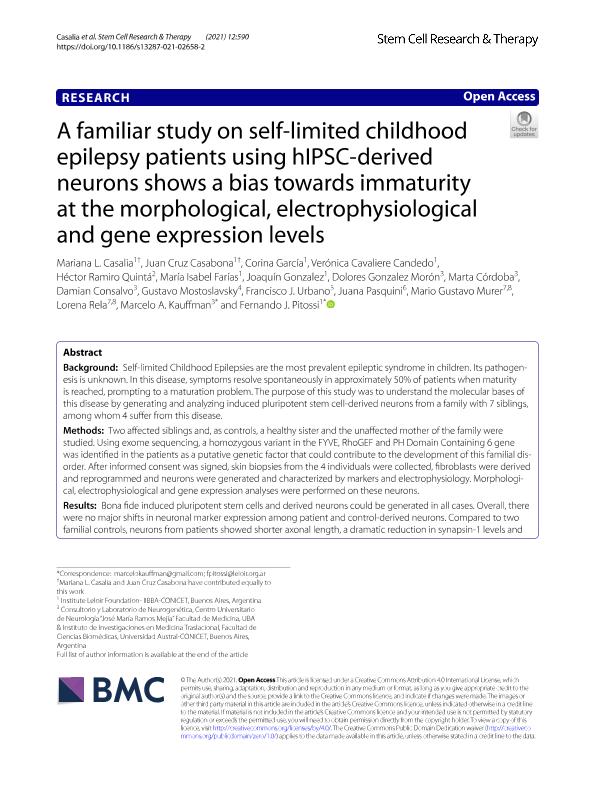Artículo
A familiar study on self-limited childhood epilepsy patients using hIPSC-derived neurons shows a bias towards immaturity at the morphological, electrophysiological and gene expression levels
Casalia, Mariana Laura ; Casabona, Juan Cruz
; Casabona, Juan Cruz ; Garcia, Corina Ileana
; Garcia, Corina Ileana ; Cavaliere Candedo, Veronica Lucia; Quintá, Héctor Ramiro
; Cavaliere Candedo, Veronica Lucia; Quintá, Héctor Ramiro ; Farias, Maria Isabel
; Farias, Maria Isabel ; Gonzalez, Joaquín; González Morón, Dolores
; Gonzalez, Joaquín; González Morón, Dolores ; Córdoba, Marta
; Córdoba, Marta ; Consalvo, Damian; Mostoslavsky, Gustavo; Urbano Suarez, Francisco Jose
; Consalvo, Damian; Mostoslavsky, Gustavo; Urbano Suarez, Francisco Jose ; Pasquini, Juana Maria
; Pasquini, Juana Maria ; Murer, Mario Gustavo
; Murer, Mario Gustavo ; Rela, Lorena
; Rela, Lorena ; Kauffman, Marcelo Andres
; Kauffman, Marcelo Andres ; Pitossi, Fernando Juan
; Pitossi, Fernando Juan
 ; Casabona, Juan Cruz
; Casabona, Juan Cruz ; Garcia, Corina Ileana
; Garcia, Corina Ileana ; Cavaliere Candedo, Veronica Lucia; Quintá, Héctor Ramiro
; Cavaliere Candedo, Veronica Lucia; Quintá, Héctor Ramiro ; Farias, Maria Isabel
; Farias, Maria Isabel ; Gonzalez, Joaquín; González Morón, Dolores
; Gonzalez, Joaquín; González Morón, Dolores ; Córdoba, Marta
; Córdoba, Marta ; Consalvo, Damian; Mostoslavsky, Gustavo; Urbano Suarez, Francisco Jose
; Consalvo, Damian; Mostoslavsky, Gustavo; Urbano Suarez, Francisco Jose ; Pasquini, Juana Maria
; Pasquini, Juana Maria ; Murer, Mario Gustavo
; Murer, Mario Gustavo ; Rela, Lorena
; Rela, Lorena ; Kauffman, Marcelo Andres
; Kauffman, Marcelo Andres ; Pitossi, Fernando Juan
; Pitossi, Fernando Juan
Fecha de publicación:
12/2021
Editorial:
BioMed Central
Revista:
Stem Cell Research and Therapy
e-ISSN:
1757-6512
Idioma:
Inglés
Tipo de recurso:
Artículo publicado
Clasificación temática:
Resumen
Background: Self-limited Childhood Epilepsies are the most prevalent epileptic syndrome in children. Its pathogenesis is unknown. In this disease, symptoms resolve spontaneously in approximately 50% of patients when maturity is reached, prompting to a maturation problem. The purpose of this study was to understand the molecular bases of this disease by generating and analyzing induced pluripotent stem cell-derived neurons from a family with 7 siblings, among whom 4 suffer from this disease. Methods: Two affected siblings and, as controls, a healthy sister and the unaffected mother of the family were studied. Using exome sequencing, a homozygous variant in the FYVE, RhoGEF and PH Domain Containing 6 gene was identified in the patients as a putative genetic factor that could contribute to the development of this familial disorder. After informed consent was signed, skin biopsies from the 4 individuals were collected, fibroblasts were derived and reprogrammed and neurons were generated and characterized by markers and electrophysiology. Morphological, electrophysiological and gene expression analyses were performed on these neurons. Results: Bona fide induced pluripotent stem cells and derived neurons could be generated in all cases. Overall, there were no major shifts in neuronal marker expression among patient and control-derived neurons. Compared to two familial controls, neurons from patients showed shorter axonal length, a dramatic reduction in synapsin-1 levels and cytoskeleton disorganization. In addition, neurons from patients developed a lower action potential threshold with time of in vitro differentiation and the amount of current needed to elicit an action potential (rheobase) was smaller in cells recorded from NE derived from patients at 12 weeks of differentiation when compared with shorter times in culture. These results indicate an increased excitability in patient cells that emerges with the time in culture. Finally, functional genomic analysis showed a biased towards immaturity in patient-derived neurons. Conclusions: We are reporting the first in vitro model of self-limited childhood epilepsy, providing the cellular bases for future in-depth studies to understand its pathogenesis. Our results show patient-specific neuronal features reflecting immaturity, in resonance with the course of the disease and previous imaging studies.
Palabras clave:
STEM CELLS
,
GENOMICS
Archivos asociados
Licencia
Identificadores
Colecciones
Articulos(IIMT)
Articulos de INSTITUTO DE INVESTIGACIONES EN MEDICINA TRASLACIONAL
Articulos de INSTITUTO DE INVESTIGACIONES EN MEDICINA TRASLACIONAL
Citación
Casalia, Mariana Laura; Casabona, Juan Cruz; Garcia, Corina Ileana; Cavaliere Candedo, Veronica Lucia; Quintá, Héctor Ramiro; et al.; A familiar study on self-limited childhood epilepsy patients using hIPSC-derived neurons shows a bias towards immaturity at the morphological, electrophysiological and gene expression levels; BioMed Central; Stem Cell Research and Therapy; 12; 1; 12-2021; 1-16
Compartir
Altmétricas



